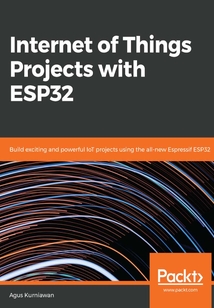舉報 

會員
Internet of Things Projects with ESP32
ESP32isalow-costMCUwithintegratedWi-FiandBLE.Variousmodulesanddevelopmentboards-basedonESP32areavailableforbuildingIoTapplicationseasily.Wi-FiandBLEareacommonnetworkstackintheInternetofThingsapplication.Thesenetworkmodulescanleverageyourbusinessandprojectsneedsforcost-effectivebenefits.ThisbookwillserveasafundamentalguidefordevelopinganESP32program.WewillstartwithGPIOprogramminginvolvingsomesensordevices.ThenwewillstudyESP32developmentbybuildinganumberofIoTprojects,suchasweatherstations,sensorloggers,smarthomes,Wi-FicamsandWi-Fiwardriving.Lastly,wewillenableESP32boardstoexecuteinteractionswithmobileapplicationsandcloudserverssuchasAWS.Bytheendofthisbook,youwillbeupandrunningwithvariousIoTproject-basedESP32chip.
目錄(177章)
倒序
- coverpage
- Title Page
- Copyright and Credits
- Internet of Things Projects with ESP32
- About Packt
- Why subscribe?
- Packt.com
- Contributors
- About the author
- About the reviewer
- Packt is searching for authors like you
- Preface
- Who this book is for
- What this book covers
- To get the most out of this book
- Download the example code files
- Conventions used
- Get in touch
- Reviews
- Getting Started with ESP32
- Technical requirements
- Introduction to ESP32
- Reviewing development boards-based ESP32
- The official ESP32 development kit
- Third-party boards-based ESP32
- Setting up the development environment
- Demo 1 – building your first ESP32 program
- Wiring
- Creating a project
- Writing the program
- Configuring the project
- Compiling and flashing
- Arduino programming for ESP32
- Demo 2 - making an Arduino Sketch program with ESP32
- Summary
- Further reading
- Making Visual Data and Animation on an LCD
- Technical requirements
- Introduction to ESP32 GPIO
- Introduction to IoT for weather monitoring systems
- Reading temperature and humidity from a sensor device
- Wiring
- Building a program
- Running the program
- Displaying information using an LCD
- Hardware wiring
- Creating a project
- Writing an ESP32 program
- Configuring the ESP-WROVER-KIT v4 board
- Flashing and running a program
- Displaying image files
- Making a weather monitoring system
- Creating a project
- Hardware wiring
- Writing a program
- Flashing and running
- Summary
- Further reading
- Building a Simple Game with an Embedded ESP32 Board
- Technical requirements
- Introducing game-embedded systems
- Introducing the joystick sensor module
- Working with the joystick sensor module
- Wiring
- Creating a project
- Writing the program
- Running the program
- Working with a sound buzzer
- Connecting the sound buzzer with the ESP32
- Writing a program for the sound buzzer with the ESP32
- Demo – building a simple embedded game
- The game scenario
- Hardware wiring
- Developing the game program
- Playing the game
- Summary
- Building a Sensor Monitoring Logger
- Technical requirements
- Introducing the sensor monitoring logger
- Accessing a microSD card from the ESP32
- Demo – accessing microSD cards from the ESP32
- Storing sensor data on a microSD card
- Project – building a sensor monitoring logger
- Designing our program
- Writing the program
- Running the program
- Summary
- Controlling IoT Devices over the Internet
- Technical requirements
- Introducing ESP32 Wi-Fi development
- Scanning Wi-Fi hotspot
- Connecting to an existing Wi-Fi network
- Accessing data from a web server
- Building your own web server inside ESP32
- Building HTTP requests
- Building a web server
- Testing the program
- Project - making a smart home
- Hardware wiring
- Handling HTTP requests
- Writing a web server program
- Testing the program
- Summary
- Building an IoT Weather Station
- Technical requirements
- Introducing a weather station
- Working with DHT sensors
- Building an IoT weather station
- Hardware wiring
- Writing the program
- Testing the program
- The auto-refresh weather application
- Handling a massive data request for a weather station
- Writing a program for ESP32
- Writing a program for Node.js
- Testing the program
- Summary
- Making Your Own Wi-Fi Wardriving
- Technical requirements
- Introducing Wi-Fi Wardriving
- Reviewing the GPS module
- Accessing your location via the GPS module
- Hardware wiring
- Writing a program
- Running a program
- Parsing GPS data
- Building your own Wi-Fi Wardriving with ESP32
- Hardware wiring
- Writing a program
- Testing a program
- Mapping Wi-Fi hotspots to Google Maps
- Privacy issues
- Summary
- Building Your Own Wi-Fi Cam
- Technical requirements
- Introducing Wi-Fi cams
- Reviewing camera modules
- Accessing the camera from ESP32
- Demo – building a Wi-Fi cam
- Hardware wiring
- Writing a program
- Handling HTTP requests
- Developing the main program
- Testing
- Summary
- Making IoT Devices Interact with Mobile Applications
- Technical requirements
- Introducing mobile applications
- Making a mobile application and ESP32 interact
- Controlling ESP32 from a mobile application
- Hardware wiring
- Developing the ESP32 program
- Developing an Android application
- Creating an Android project
- Configuring the Android project
- Building the UI Android program
- Writing an Android program
- Testing a program with Postman
- Testing the program with Android
- Summary
- Building IoT Monitoring with Cloud Technology
- Technical requirements
- Introducing cloud technology
- Connecting ESP32 to cloud platforms
- Building IoT monitoring with ESP32 and AWS
- Hardware wiring
- Registering an IoT device
- Configuring a device security policy
- Developing an ESP32 program
- Creating a project
- Configuring a project
- Writing the ESP32 program
- Compiling flashing and testing
- Summary
- Further reading
- Other Books You May Enjoy
- Leave a review - let other readers know what you think 更新時間:2021-06-24 16:03:24
推薦閱讀
- Intel FPGA/CPLD設計(基礎篇)
- 零點起飛學Xilinx FPG
- Applied Unsupervised Learning with R
- 嵌入式技術基礎與實踐(第5版)
- Mastering Adobe Photoshop Elements
- Visual Media Processing Using Matlab Beginner's Guide
- CC2530單片機技術與應用
- R Deep Learning Essentials
- Machine Learning with Go Quick Start Guide
- 筆記本電腦維修實踐教程
- Neural Network Programming with Java(Second Edition)
- IP網絡視頻傳輸:技術、標準和應用
- Istio實戰指南
- 計算機組裝與維護(慕課版)
- Corona SDK Mobile Game Development:Beginner's Guide
- 計算機應用基礎案例教程(Windows 7+Office 2010)
- MicroPython Cookbook
- Nagios系統監控實踐(原書第2版)
- 微型計算機原理及應用教程(第2版)
- Mastering Unity 2D Game Development
- 實戰Alibaba Sentinel:深度解析微服務高并發流量治理
- 21天學通筆記本電腦維修
- 主板維修精華秘籍
- 32位嵌入式微處理器原理及應用
- Spring Cloud微服務:入門、實戰與進階
- 嵌入式系統軟硬件協同設計實戰指南:基于Xilinx ZYNQ(第2版)
- 最新電腦故障排除即時通
- 筆記本電腦維修寶典
- 多媒體技術應用實訓教程
- 全圖解電腦組裝與維修實用大全(視頻教程版、Windows 10適用)

